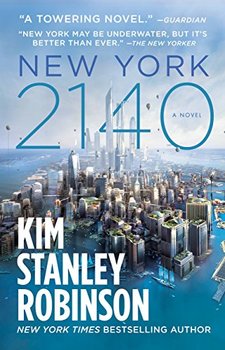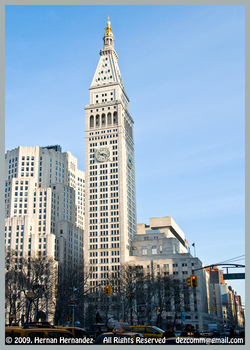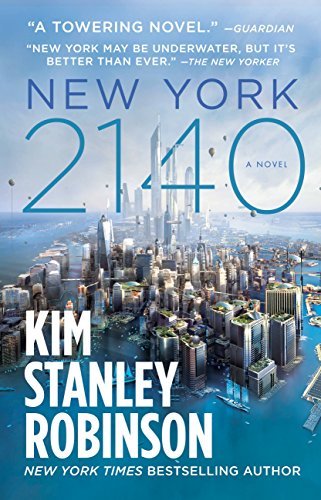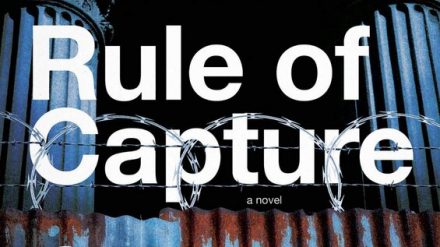
What will life on Earth be like a century from now once the oceans have risen fifty feet or more? This is the central question the acclaimed science fiction writer Kim Stanley Robinson sets out to explore in his ambitious new novel, New York 2140.
Estimated reading time: 6 minutes
Robinson’s canvas is New York City. Far uptown in Manhattan, on Brooklyn Heights, and in Hackensack, 300-story “superscrapers” built of graphene composites pierce the clouds. There, the world’s richest people own luxurious apartments they rarely occupy for more than a week or two every year. Everything south of midtown is underwater up to the third or fourth story, yet for many New Yorkers life goes on there above the waterline in the high-rise buildings that have survived the flooding. They travel about on skybridges that connect the towers, on the waters that frame Manhattan island, and on canals that traverse what were once streets and avenues.
“The floods of the twenty-first century,” Robinson writes, “revealed a salient fact that wasn’t very important before: lower Manhattan is indeed much lower than upper Manhattan, like by about fifty vertical feet on average.” Smaller numbers of people live in “skyvillages” held aloft by arrays of helium-filled balloons and on floating townships that traverse the open seas.
The action unfolds over the course of three years beginning in 2140, most of it in or near the 40-story MetLife Tower at Madison Avenue and 24th Street (not to be confused with the iconic 59-story building at 200 Park Avenue also known as the MetLife Tower). Some 2,000 people now live there in Robinson’s tale.
New York 2140 by Kim Stanley Robinson (2017) 624 pages ★★★★★
Finalist for the 2018 Hugo Award for Best Novel
A grim picture of New York in 2140

Nine principal characters
Robinson tells his story through the eyes of nine principal characters, three of whom are officials:
- Charlotte Armstrong is the long-time chair of the residents’ association at the Met and influential within the network of her peers in similar buildings across lower Manhattan.
- NYPD Inspector Gen Octaviasdottir is, ironically given her Icelandic name, a huge African-American woman, six-four in her police boots. She is “one of the city’s most distinguished inspectors, famous downtown and in those parts of the cloud interested in police work.” Gen is often at odds with her superiors in the Department because of their tendency to favor the superrich who live in the ‘scrapers.
- Vlade Marovich, the superintendent at “the Met”—the building, not the Metropolitan Museum or the Metropolitan Opera—manages a large staff dedicated to keeping the water out.
Residents at “the Met”
- A day-trader for a large hedge fund engaged in “high-frequency geofinance,” Franklin Garr, lives at the Met, like Charlotte, Gen, and Vlade. Franklin is forever scheming about how to make a killing, which he assumes will involve short-selling when the intertidal economy crashes—and he may not be averse to helping make that happen.
- Several other key characters are temporary residents of the building, at least initially. A pair of programmers known as Mutt and Jeff (Ralph Muttchopf and Jeff Rosen) have taken refuge in a tent on the farm floor high in the Met, having lost their jobs working for a crooked hedge fund manager. Like so many others in the world of finance, they gain little benefit from the work they do to make others rich. (“They are partners, they amuse each other, they work long hours writing code for high-frequency trading computers uptown.”)
- A pair of energetic young orphan boys, aged ten and twelve, named Stefan and Roberto end up at the Met when they’re rescued from drowning by Vlade and Franklin; they typify the “river rats” who eke out a precarious existence on the fringes of the island.
And a famous “cloud star”
A famous “cloud star” named Amelia is another latecomer to the Met. She rides in an airship around the world rescuing endangered species and relocating them to more hospitable surroundings. Amelia is a klutz, forever getting into trouble, which her fans love. She is also gorgeous and attracts a great deal of attention from viewers by frequently traveling nude.
Robinson spins out his story in short chapters that alternate from one of these nine characters to another. Interspersed among these episodes that carry the plot forward are essays on the state of the world in the mid-22nd century, framed as the musings of a nameless “citizen.” Through these lively essays, written in beautifully crafted idiomatic prose, Robinson conveys extensive knowledge not just of ecology—he is widely recognized as a well-informed environmental activist—but of politics and finance as well.
Economic issues are at the heart of this novel
The financial structure of the society he envisions is at the heart of this story: economic inequality has run amok, and the superrich uptown are threatening to gain control even of the high-rise buildings in the “intertidal” downtown where their less prosperous neighbors live. In other words, this is a society ripe for revolution. The conflict between the people of the intertidal and downtown, on the one hand, and the lords of finance uptown plays out in the course of this long, deeply satisfying novel.
Most of us who follow the news these days are prone to think of global warming and rising seas as slow, gradual processes, imperceptible over short periods of time. Robinson postulates sudden change, which I’m persuaded is actually more likely. He envisions a “First Pulse,” when the level of the sea rose by ten feet in ten years in the 2060s and an even more severe “Second Pulse” that added a further forty feet over the fifteen years from 2085 to 2100. After all, nature doesn’t travel in straight lines.
Kim Stanley Robinson is best known as the author of the now-classic Mars Trilogy: Red Mars, Green Mars, and Blue Mars. Among the many awards he has won are the Hugo and the Nebula. In a New Yorker article in 2013, Robinson was termed “our greatest political novelist.” New York 2140 confirms that judgment.
For related reading
Not long ago, I reviewed another of Robinson’s novels, Aurora. I enjoyed it a lot less. My review is at A major new science fiction novel from Kim Stanley Robinson.
This book is included in 20 good nonfiction books about the future (plus lots of science fiction). It’s also one of many Good books about climate change I’ve reviewed here.
For more good reading, check out:
- These novels won both Hugo and Nebula Awards
- The ultimate guide to the all-time best science fiction novels
- 10 top science fiction novels
- The top 10 dystopian novels
- Ten new science fiction authors worth reading now
And you can always find my most popular reviews, and the most recent ones, on the Home Page.



























